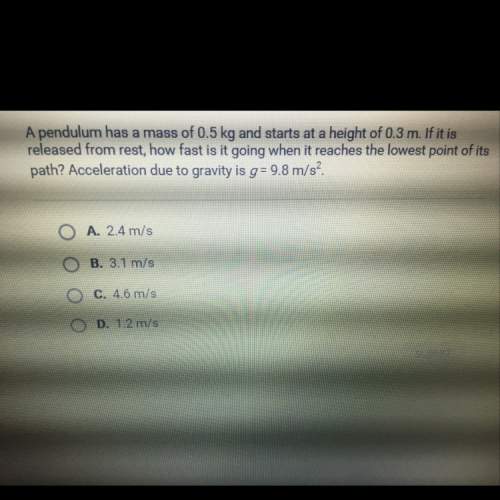20 points! i need with these
calculate the speed of a turtle that walked 280 centimeters i...


Answers: 1


Other questions on the subject: Physics

Physics, 21.06.2019 22:00, Angelo1660
Air is held within a frictionless piston-cylinder container, which is oriented vertically. the mass of the piston is 0.45 kg and the cross-sectional area is 0.0030 m2. initially (state 1) the pressure of the gas is sufficient to support the weight of the piston as well as the force exerted by the atmospheric pressure ( 101.32 kpa). the volume occupied by the air within the cylinder in state 1 is 1.00 liter. one end of a spring (with spring constant k = 1000 n/m) is attached to the top of the piston, while the other end of the spring is attached to a stage that can move vertically. initially the spring is undeflected and therefore exerts no force. then the stage is then moved quasistatically downward a distance of 10.0 cm, at which point the system reaches state 2. the piston-cylinder is not insulated; rather it remains in diathermal contact with the surroundings, which are at a constant temperature of 300 k. what is the change of pressure within the container?
Answers: 3

Physics, 22.06.2019 01:10, caguil00
Asteam power plant operates on an ideal reheat rankine cycle between the pressure limits of 15 mpa and 10 kpa. the mass flow rate of steam through the cycle is 12 kg/s. steam enters both stages of the turbine at 500°c. if the moisture content of the steam at the exit of the low-pressure turbine is not to exceed 10 percent, determine (a) the pressure at which reheating takes place, (b) the total rate of heat input in the boiler, and (c) the thermal efficiency of the cycle. also, show the cycle on a t-s diagram with respect to the saturation lines. (2.15 mpa; 45.0 mw; 42.6%)
Answers: 3

Physics, 22.06.2019 01:40, sasalinas2001
In all trials, the magnitude of the final velocity for g1 + g2 was less than the magnitude of any initial velocity. as mass increased, what happened to the velocity? the velocity decreased. the velocity increased. the velocity of g1 + g2 could not be measured. the velocity was not affected by the mass increase.
Answers: 1
You know the right answer?
Questions in other subjects:

History, 02.04.2021 20:20






Spanish, 02.04.2021 20:20

English, 02.04.2021 20:20

Mathematics, 02.04.2021 20:20

Mathematics, 02.04.2021 20:20




